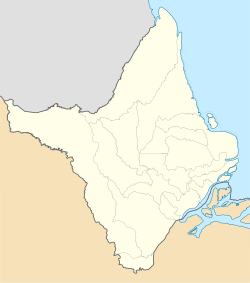Pirativa
Pirativa | |
|---|---|
| Coordinates: 0°03′35″N 51°17′58″W / 0.0596°N 51.2995°W | |
| Country | |
| Region | North |
| State | Amapá |
| Municipality | Santana |
| Population (2010)[1] | |
| • Total | 591 |
| Time zone | UTC-3 |
Pirativa is a district in the Brazilian municipality of Santana, in the state of Amapá. It is located along the Pirativa River.[2] São Raimundo do Pirativa, a village in the district, has been recognized as a quilombo, a settlement by escaped slaves.[3]
Overview[edit]
Pirativa is an agricultural area. The main products are cassava and pineapples. The district is known for the annual Cassava Festival.[4] Pirativa has a school, but no clinic. The district can only be accessed by boat.[2] In 2001, Pirativa became a district of Santana.[5]
São Raimundo do Pirativa[edit]
São Raimundo do Pirativa was recognised as a quilombo in 2013, and has its own territory of 23.4 hectares (58 acres) similar to the indigenous territories.[3] The neighbouring village of Alto do Pirativa has also applied for recognition, but as of 2021, it has not been certified.[6]
Malaria trial[edit]
In 2003,[2] a clinical trial by the University of Florida was launched in São Raimundo do Pirativa. 10 healthy volunteers were subjected to 100 mosquito bites in a malaria trial,[7] and were paid R$ 108 for participation. Not only did all cases contract malaria, the number of malaria cases in the region went up from four to 30 cases.[2] The University of Florida has denied that people caught malaria as a result of the project, and claimed that the allegations were unproven. The trial has been suspended, and an investigation into the ethics of the trial was launched.[7]
References[edit]
- ^ Instituto Brasileiro de Geografia e Estatística (IBGE) (16 November 2011). "Sinopse por setores". Retrieved 1 April 2021.
- ^ a b c d "Cobaias humanas "made in Brazil"". Agência Senado (in Portuguese). Retrieved 3 April 2021.
- ^ a b "São Raimundo do Pirativa". Comissão Pró-Índio de São Paulo (in Portuguese). 22 February 2017. Retrieved 3 April 2021.
- ^ "Visit Santana". Visite o Brasil (in Portuguese). Retrieved 3 April 2021.
- ^ "Santana". IBGE (in Portuguese). Retrieved 3 April 2021.
- ^ "Alto Pirativa". Comissão Pró-Índio de São Paulo (in Portuguese). 21 February 2017. Retrieved 3 April 2021.
- ^ a b "US research 'endangered Amazon villagers'". The Guardian. 20 December 2005. Retrieved 3 April 2021.


